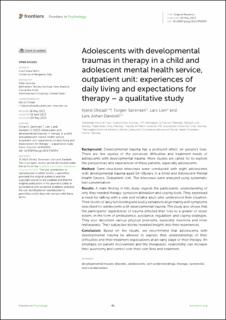| dc.contributor.author | Olstad, Kjersti | |
| dc.contributor.author | Sørensen, Torgeir | |
| dc.contributor.author | Lien, Lars | |
| dc.contributor.author | Danbolt, Lars Johan | |
| dc.date.accessioned | 2023-11-24T08:32:30Z | |
| dc.date.available | 2023-11-24T08:32:30Z | |
| dc.date.created | 2023-06-16T14:36:34Z | |
| dc.date.issued | 2023 | |
| dc.identifier.citation | Frontiers in Psychology. 2023, 14 | en_US |
| dc.identifier.issn | 1664-1078 | |
| dc.identifier.uri | https://hdl.handle.net/11250/3104467 | |
| dc.description | This is an open-access article distributed under the terms of the Creative Commons Attribution License (CC BY). The use, distribution or reproduction in other forums is permitted, provided the original author(s) and the copyright owner(s) are credited and that the original publication in this journal is cited, in accordance with accepted academic practice. No use, distribution or reproduction is permitted which does not comply with these terms. | en_US |
| dc.description.abstract | Background: Developmental trauma has a profound effect on people’s lives. There are few studies of the perceived difficulties and treatment needs of adolescents with developmental trauma. More studies are called for to explore the perspectives and experiences of these patients, especially adolescents.
Method: Semi-structured interviews were conducted with eight adolescents with developmental trauma aged 14–18 years in a Child and Adolescent Mental Health Service, Outpatient Unit. The interviews were analyzed using systematic text condensation.
Results: A main finding in this study regards the participants’ understanding of why they needed therapy: symptom alleviation and coping tools. They expressed a need for talking with a safe and reliable adult who understood their situation. Their stories of daily functioning and bodily sensations align mainly with symptoms described for adolescents with developmental trauma. The study also shows that the participants’ experiences of trauma affected their lives to a greater or lesser extent, in the form of ambivalence, avoidance, regulation, and coping strategies. They also described various physical problems, especially insomnia and inner restlessness. Their subjective stories revealed insights into their experiences.
Conclusion: Based on the results, we recommend that adolescents with developmental trauma be allowed to express their understandings of their difficulties and their treatment expectations at an early stage of their therapy. An emphasis on patient involvement and the therapeutic relationship can increase their autonomy and control over their own lives and treatment. | en_US |
| dc.language.iso | eng | en_US |
| dc.publisher | Frontiers Media | en_US |
| dc.relation.uri | https://www.frontiersin.org/articles/10.3389/fpsyg.2023.946394/full | |
| dc.rights | Navngivelse 4.0 Internasjonal | * |
| dc.rights.uri | http://creativecommons.org/licenses/by/4.0/deed.no | * |
| dc.subject | systematic text condensation | en_US |
| dc.subject | therapy | en_US |
| dc.subject | self-understandings | en_US |
| dc.subject | adolescents | en_US |
| dc.subject | developmental trauma disorder | en_US |
| dc.title | Adolescents with developmental traumas in therapy in a child and adolescent mental health service, outpatient unit: experiences of daily living and expectations for therapy – a qualitative study | en_US |
| dc.type | Peer reviewed | en_US |
| dc.type | Journal article | en_US |
| dc.description.version | publishedVersion | en_US |
| dc.rights.holder | © 2023 Olstad, Sørensen, Lien and Danbolt | en_US |
| dc.source.pagenumber | 1-8 | en_US |
| dc.source.volume | 14 | en_US |
| dc.source.journal | Frontiers in Psychology | en_US |
| dc.identifier.doi | 10.3389/fpsyg.2023.946394 | |
| dc.identifier.cristin | 2155322 | |
| cristin.ispublished | true | |
| cristin.fulltext | original | |
| cristin.qualitycode | 1 | |

